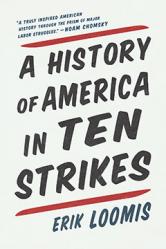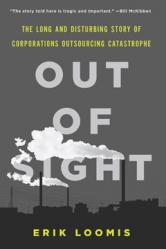AUTHOR SPOTLIGHT: Erik Loomis
In honor of Labor Day, we sit down with Erik Loomis (author of A History of America in Ten Strikes) to discuss his thrilling and timely account of ten moments in history when labor challenged the very nature of power in America. His op-ed “Serving Time Should Not Mean ‘Prison Slavery’” on the current national prison strike and its demand to end forced prison labor is in today's New York Times.
Loomis is an associate professor of history at the University of Rhode Island. He blogs at Lawyers, Guns, and Money on labor and environmental issues past and present. His work has also appeared in the New York Times, the Washington Post, Dissent, and the New Republic. The author of Out of Sight (The New Press) and Empire of Timber, he lives in Providence, Rhode Island.
What are the two most important lessons that today’s activists and labor organizers should learn from this book?
ERIK LOOMIS: First, the only way to create emancipation for workers is to embrace an anti-racist and anti-sexist America. The argument that class matters more than race in the past or present contributes to white supremacy by erasing the lived experience of workers of color and not confronting how white workers will so often choose their white identity over their class identity. The struggle against racism and the struggle against poverty cannot be separated. We will never have a nation that embraces economic equality if we do not fight racial and sexual inequality at the same time. That means embracing immigrants, not demonizing them. That means that jobs traditionally seen as women’s work—including unpaid housework—are important to the class struggle.
Second, the history of strikes and workers shows that workers can only win long-term or even short-term victories if the government is a neutral arbiter or is favorable to unions. For most of American history, government and employers have allied to crush workers’ rights. That is what we are seeing today once again. The only way to stop this is to organize workers and then participate in electoral politics to elect workers and their supporters and hold them accountable for their actions. The huge wins for labor in the 1930s happened because of enormous organizing efforts, but they still required a president such as Franklin Delano Roosevelt, who signed pro-labor legislation, and governors such as Michigan’s Frank Murphy, who allowed General Motors’ workers to sit in the Flint plant rather than using the National Guard to forcibly evict them, as the company demanded. Workers elected these people because they organized to demand change. When workers take over one of the two major political parties again, that is when they will be most likely to reverse the current trend against workers’ rights. That has to be the electoral goal of the workers’ struggle.
Recently, the U.S. Supreme Court dealt a structural blow to organized labor in Janus v. AFSCME. How does the regulatory and political environment for organized labor compare to previous periods in American history? Which structures for the organization of worker power do you think are most promising today?
EL: The regulatory and political environment of the present has become quite similar to that of the era before the Great Depression, when corporations ran amuck, when inequality ran rampant, and when the Supreme Court created logic-free justifications to strike down workers’ rights in ways that apply nowhere else in American life. My book discusses many Supreme Court decisions of the early twentieth century that are quite similar to Janus in this way.
This is a grim time for workers’ rights, yet it is also a time when a new generation of struggle is building that may transform our nation sooner than we think. One problem we face is that Republican courts will continue to create justifications to restrict unions. I don’t know if there is a single method that we can say will work today. We can’t know what will succeed but we can know that new generations of innovative organizers will eventually break through this morass and help create a better and more equal future.
What is the role of race and gender in American labor history?
EL: Race and gender are absolutely central to American labor history. We can’t understand our labor history without placing these categories at the center of our analysis. The hope of slaves for equality after the Civil War crashed against the rocky shores of a white supremacy very much embraced by most white workers.
The first major piece of national legislation passed that had originated in the labor movement was the Chinese Exclusion Act. The same white workers who organized the big industrial plants of the North in the 1930s and 1940s often drew the line at racial equality and, in most unionized workplaces, black workers had the hardest and most dangerous jobs for decades while also unable to rise to positions of leadership within the unions. Moreover, unions knew that unless they organized the South, companies would move their unionized factories to those non-union states. But the attempts to do that foundered when white southern workers feared that unions would practice racial integration. These campaigns mostly failed. In fact, companies moved their union factories to the non-union south, where unions continue to struggle to organize today.
The only path toward emancipating workers is placing the fight against racism at the center of our struggles, changing the minds of whites who prioritize their white identity over their class identity. Gender is also critically important, in part because our view of workers’ history is inherently sexist. Too often, we have focused on factories and other all- or mostly male worksites in our labor history. But women have always worked too: as unpaid labor in the home, as low-paid factory labor, as sex workers. These are all forms of labor. Then, when women did enter the male-dominated workplace, men relegated women to low pay and sexually harassed them on the job, while unions remained dominated by men. The myth of the single-family income, which inherently meant a man working and a wife staying at home, has great power in our society and has blinded even labor activists to the sexism of this American ideal. The new organizing is led mostly by women and people of color. Race and gender will be absolutely central to a reinvigorated labor movement and we need to reconsider our history to focus on women and people of color as well.
Your previous book, Out of Sight, focused on workers’ power in the global context, while this book focuses on the American story. How does American labor history impact workers around the globe? How should American workers today find and express solidarity with workers around the world, as immigration and globalization are becoming the fault lines along which American politics is breaking?
EL: In the modern world, American workers and workers overseas are deeply connected. The system of global capitalism, with corporations moving all over the world looking for the cheapest labor, affects everyone. It has destroyed American unions and the middle class while also ensuring that workers from Mexico to Bangladesh are unable to build their own middle classes. International labor solidarity is hard. Workers speak different languages, they have different cultures, and because workers, whether in the U.S. or overseas, often put their identities around race, religion, and nationality over that of their class, they too often demonize workers from other countries. This has to be fought if we are to tame the multinational corporations who rule our lives.
Workers overseas aren’t “stealing our jobs.” Our companies are stealing our jobs from us. Immigrants aren’t coming to the United States to take our jobs. They are coming to create better lives for themselves and their families. American workers must embrace immigrants and overseas workers if solidarity means anything to them.
We must fight to demand new legislation that evens the playing field for all workers, taking away the incentive for companies to keep moving to find cheaper labor. In several venues, I have proposed what I call the Corporate Accountability Act, requiring that corporations and their suppliers live up to standards around minimum wages, safe working conditions, pollution, allowing workers to form unions, and banning both sexual harassment on the job and child labor. Moreover, such a law should allow workers and citizens overseas to sue in American courts for financial damages to force American companies to follow these laws. I have also proposed the federal guarantee of a job for all Americans, a proposal that nearly became law in the 1970s, which would force the government to create good-paying jobs for any American who wanted one. We need to propose new legislation to tame global capitalism if we want to recreate the relative economic equality of the mid-twentieth century.



